prisoners
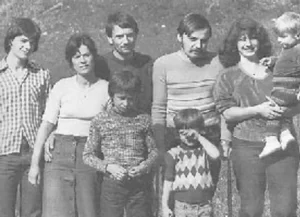 It all happened overnight. The people of East Berlin became prisoners of their government. The government was oppressive, and people wanted to leave. The government could not have that, so walls were put up encircling the city virtually overnight. East Germany was now a part of the Eastern Bloc, and it was separated from West Germany in the Western Bloc by the inner German border and the Berlin Wall, which were heavily fortified with watchtowers, land mines, armed soldiers, and various other measures to prevent illegal crossings. The people were prisoners, and the East German border troops were instructed to prevent defection to West Germany by all means, including lethal force (Schießbefehl; “order to fire”). Many people attempted escape, and many people died trying.
It all happened overnight. The people of East Berlin became prisoners of their government. The government was oppressive, and people wanted to leave. The government could not have that, so walls were put up encircling the city virtually overnight. East Germany was now a part of the Eastern Bloc, and it was separated from West Germany in the Western Bloc by the inner German border and the Berlin Wall, which were heavily fortified with watchtowers, land mines, armed soldiers, and various other measures to prevent illegal crossings. The people were prisoners, and the East German border troops were instructed to prevent defection to West Germany by all means, including lethal force (Schießbefehl; “order to fire”). Many people attempted escape, and many people died trying.
One of the people who refused to give up and settle for imprisonment was Peter Strelzyk (born 1942), an electrician and former East German Air Force mechanic. Strelzyk, along with his friend, Günter Wetzel (born 1955), who was a bricklayer by trade, were determined to get out of East Berlin. The men had been colleagues at a local plastics factory for four years. They had long shared a desire to get out of the country and make a better life for their families. They began discussing, albeit very quietly, how they might make their escape. On March 7, 1978, they decided that they were done living that way and began to plan an escape. Their first thought was to build a helicopter. Then, they realized that they would be unable to acquire an engine capable of powering such a craft. Then, their imaginations alighted on the thought of building a hot air balloon. That idea came about after they watched a television program about ballooning. Some say that they got the idea after a relative shared a magazine article about the International Balloon Festival in Albuquerque, New Mexico. It really doesn’t matter where the idea came from, because they main thing is that they cose a hot air balloon as their escape vehicle.
The decision made, Strelzyk and Wetzel began research into balloons. The plan was to escape with their wives and a total of four children, aged 2 to 15. This was going to have to be a big balloon to hold eight passengers and the basket they would ride in. They calculated the weight of the eight passengers and the craft itself to be around 1,650 pounds. With that in mind, they knew that would need a balloon that could carry the weight would need to hold 71,000 cubic feet of air heated to 212 °F. The next calculation was the amount of material needed for the balloon itself, estimated to be 8,600 square feet.
The pair lived in Pößneck, a small town of about 20,000 where large quantities of cloth could not be obtained without raising attention. There were a number of things that raised suspicion, and a number of people in East Berlin who were all too willing to tell the authorities what they saw and heard. The two men tried neighboring towns of Rudolstadt, Saalfeld, and Jena without success. They travelled 31 miles to Gera, where they were finally able to purchase 3 feet 3 inch wide rolls of cotton cloth totaling 850 2,790 feet in length at a department store after telling the astonished clerk that they needed the large quantity of material to use as tent lining for their camping club.
Wetzel spent two weeks sewing the cloth into a balloon-shaped bag, 49 feet wide by 66 feet long, using a 40-year-old manually operated sewing machine. Strelzyk spent the time building the gondola and burner assembly. The gondola was made from an iron frame, sheet metal floor, and clothesline run around the perimeter every 5.9 inches for the sides. The burner was made using two 24-pound bottles of liquid propane household gas, hoses, water pipe, a nozzle, and a piece of stove pipe.
Finally, in April 1978, the balloon was ready to be tested. For several days, the men searched for just the right spot for the test. The site had to be secluded and yet have a good-sized clearing. They settled on a forest clearing near Ziegenrück, 6.2 miles from the border and 19 miles from Pößneck. Unfortunately, when they tried to inflate the balloon, the heated air from the burner would not move into the balloon. They thought the problem might stem from the fact that they had laid the balloon on the ground. After weeks of additional searching, they found an 82-foot cliff at a rock quarry where they could suspend the balloon vertically before inflation. Unfortunately, that plan also failed.
In the most dramatic invention to date, the men decided to fill the bag with ambient-temperature air before using the burner to raise the air temperature and provide lift. For this, the men constructed a blower with a 14 horsepower 250 cc 15 cubic inch motorcycle engine, started with a Trabant automobile starter powered by jumper cables from Strelzyk’s Moskvitch sedan. The engine, which was quieted by a Trabant muffler. The engine turned 3.3 feet fan blades to inflate the balloon. They also used a home-made flamethrower, similar to the gondola’s burner, to pre-heat the air faster. With these modifications in place, they returned to the secluded clearing to try again, and again the plan failed to inflate the balloon. At this point, they discovered that the cotton material was the problem. It was just too porous, and the heated air quickly seeped out. That unsuccessful attempt had cost them 2,400 DDM. Strelzyk disposed of the cloth by burning it in his furnace over several weeks.
The men went back to the drawing board. Strelzyk and Wetzel purchased samples of different fabrics in local stores, including umbrella material and various samples of taffeta and nylon. Then they used an oven to test the material for heat resistance. They also created a test rig from a vacuum cleaner and a water-filled glass tube to determine which material would allow the vacuum to exert the most suction on the water, and consequently which was the most impervious to air. Of the materials tested, the umbrella covering performed the best, but it was also the most expensive. In the end, they instead selected a synthetic kind of taffeta.
Once again, the men traveled to a distant city to make their purchases so they wouldn’t arouse suspicion. This time they travelled over 100 miles to a department store in Leipzig. Their new cover story was that they belonged to a sailing club and needed the material to make sails. They were extremely worried that the purchase could alert East Germany’s State Security Service (Stasi). Nevertheless, they returned the next day and picked up the material without incident. They paid 4,800 DDM (US$720) for 2,600 feet of 3-foot 3-inch  fabric. On the way home, they also purchased an electric motor to speed up the pedal-operated sewing machine they had been using to sew the material into the desired balloon shape.
fabric. On the way home, they also purchased an electric motor to speed up the pedal-operated sewing machine they had been using to sew the material into the desired balloon shape.
Wetzel spent the next week sewing the material into another balloon. The new motor made the work much faster. Before long they were ready. Soon afterwards, they returned to the forest clearing and inflated the bag in about five minutes using the blower and flame thrower. It was amazing!! Unfortunately, there was s glitch. The bag rose and held air, but the burner on the gondola was not powerful enough to create the heat needed for lift. The pair continued experimenting for months, doubling the number of propane tanks and trying different fuel mixtures. Disappointed with the result, Wetzel decided to abandon the project and instead started to pursue the idea of building a small gasoline engine-powered light aeroplane or a glider.
Strelzyk, however, refused to give up. He continued trying to improve the burner. In June 1979, he discovered that with the propane tank inverted, additional pressure caused the liquid propane to evaporate, which produced a bigger flame. He modified the gondola to mount the propane tanks upside down, and returned to the test site where he found the new configuration produced a 39-foot-long flame. Strelzyk was ready to attempt an escape.
Now down to just four people, the Strelzyk family chose July 3, 1979, and go-day. The weather and wind conditions were favorable. The entire Strelzyk family lifted from a forest clearing at 1:30 am and climbed at a rate of 13 feet per second. They reached an altitude of 6,600 feet according to an altimeter Strelzyk had made by modifying a barometer. A light wind was blowing them towards the border. The balloon then entered clouds, and atmospheric water vapor condensed on the balloon, adding weight which caused it to descend prematurely. The family landed safely…but they were approximately 590 feet short of the border, at the edge of the heavily mined border zone. It was a terrifying situation. At first, they weren’t sure where they were, but Strelzyk explored until he found a piece of litter…a bread bag from a bakery in Wernigerode, an East German town. The terrified family spent nine hours carefully extricating themselves from the 1,600-foot-wide border zone to avoid detection. They also had to travel unnoticed through a 3.1-mile restricted zone before hiking back a total of 8.7 mile to their car and the launch paraphernalia they had left behind. Amazingly, while the balloon was found, their car had not been. They made it home just in time to report absent due to sickness from work and school and go to be to get some much-needed rest.
The abandoned balloon was discovered by the authorities later that morning, and Strelzyk destroyed all compromising evidence and sold his car, fearing that it could link him to the escape attempt. On August 14th, the Stasi launched an appeal to find the “perpetrator of a serious offence” and listed in detail all the items recovered at the landing site. Strelzyk felt that the Stasi would eventually trace the balloon to him and the Wetzels. He agreed with Wetzel that their best chance was to quickly build another balloon and get out as soon as possible.
At this point, Wetzel again joined Strelzyk. They doubled the balloon’s size to 140,000 cubic feet in volume, 66 feet in diameter, and 82 feet in height. They needed 13,500 square feet of taffeta, and purchased the material, in various colors and patterns, all over the country in order to escape suspicion. Wetzel sewed a third balloon, using over 3.7 miles of thread, and Strelzyk rebuilt everything else as before. They worked feverishly, because they knew their time was very limited. The authorities were closing in on them. In six weeks, they had prepared the 400-pound balloon and a payload of 1,210 pound, including the gondola, equipment, and cargo of eight people. Confident in their calculations, they found the weather conditions right on September 15, 1978, when a violent thunderstorm created the correct winds. The two families set off for the launch site in Strelzyk’s replacement car (a Wartburg) and a moped. Arriving at 1:30 am, they needed just ten minutes to inflate the balloon and an additional three minutes to heat the air.
They lifted off just after 2:00 am, and in their hurry, the group failed to cut the tethers holding the gondola to the ground at the same time, tilting the balloon and sending the flame towards the fabric, which caught fire. They quickly got the fire out, because they had prepared for such an emergency. Then the balloon climbed to 6,600 feet in nine minutes, drifting towards West Germany at 9 miles per hour. The balloon flew for 28 minutes, with the temperature plummeting to 18 °F in the unsheltered gondola, which consisted solely of clothesline railing. Nevertheless, they pressed on.
A design miscalculation resulted in the burner stovepipe being too long, causing the flame to be too high in the balloon, creating excessive pressure which caused the balloon to split. While they had to use the burner more that they had hoped, they kept the balloon in the air. At one point, they increased the flame to the maximum possible extent and rose to 8,200 feet. They later learned they had been high enough to be detected, but not identified, on radar by West German air traffic controllers. They had also been detected on the East German side by a night watchman at the district culture house in Bad Lobenstein. The report of an unidentified flying object heading toward the border caused guards to activate search lights, but the balloon was too high and out of reach of the lights. God had protected the families.
When the propane ran out, the balloon descended quickly, landing near the town of Naila, in the West German state of Bavaria and only 6 miles from the border. The only injury was suffered by Wetzel, who broke his leg upon landing. Various clues indicated to the families that the balloon had made it across the border. These included spotting red and yellow colored lights, not common in East Germany, and small farms, in contrast to the large state-run operations in the east. Another clue was modern farm equipment, unlike the older equipment used in East Germany. Two Bavarian State Police officers saw the balloon’s flickering light and headed to where they thought it would land. There they found Strelzyk and Wetzel, who first asked if they had made it to the west, although they noticed the police car was an Audi…another sign they were in West Germany. Upon learning they had, the escapees happily called for their families to join them.
Of course, East Germany immediately increased border security, closed all small airports close to the border, and ordered the planes kept farther inland. Propane gas tanks became registered products, and large quantities of fabric suitable for balloon construction could no longer be purchased. Mail from East Germany to the two escaped families was prohibited.
Erich Strelzyk learned of his brother’s escape on the ZDF news and was arrested three hours after the landing in his Potsdam apartment. The arrest of family members was standard procedure to deter others from attempting escape. He was charged with “aiding and abetting escape”, as were Strelzyk’s sister Maria and her 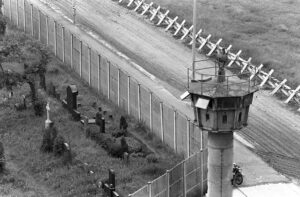 husband, who were sentenced to 2½ years. The three were eventually released with the help of Amnesty International.
husband, who were sentenced to 2½ years. The three were eventually released with the help of Amnesty International.
The families decided to initially settle in Naila where they had landed. Wetzel worked as an automobile mechanic and Strelzyk opened a TV repair shop in Bad Kissingen. Due to pressure from Stasi spies, the Strelzyks moved to Switzerland in 1985. After German reunification in 1990, they returned to their old home in their hometown of Pößneck. The Wetzels remained in Bavaria. Peter Strelzyk died in 2017 at age 74 after a long illness. In 2017, the balloon was put on permanent display at the Haus der Bayerischen Geschichte: Museum in Bavaria.
 What would you do if your life had been ripped apart by a group of people who really knew nothing about you or your people, but hated you and them anyway. That was the position in which Joseph Harmatz found himself. Born in Rokiškis, Lithuania into a prosperous family, Harmatz and his family were transferred to the Vilnius Ghetto on January 23, 1925, after the occupation of Lithuania by Nazi Germany. It was the worst time in his life. His youngest brother and all of his grandparents were killed and his older brother died during a military action. His despondent father committed suicide. Harmatz was left alone with his mother at the age of 16. He couldn’t stand the way things were, so he left the ghetto through the sewers and joined a band of guerrillas fighting the Nazis. Harmatz managed to survive the Holocaust, and after the war, he became part of Nakam (Hebrew for Revenge) also known as the Avengers. The Nakam was a group of 50 former underground fighters led by Abba Kovner. Their goal was to avenge the deaths of the six million Jewish victims of Nazi extermination efforts in the Holocaust. The true goal according to Harmatz was to facilitate the death of as many Germans as possible, with the group planning “to kill six million Germans, one for every Jew slaughtered by the Germans,” acknowledging that the effort “was revenge, quite simply. Were we not entitled to our revenge, too?”
What would you do if your life had been ripped apart by a group of people who really knew nothing about you or your people, but hated you and them anyway. That was the position in which Joseph Harmatz found himself. Born in Rokiškis, Lithuania into a prosperous family, Harmatz and his family were transferred to the Vilnius Ghetto on January 23, 1925, after the occupation of Lithuania by Nazi Germany. It was the worst time in his life. His youngest brother and all of his grandparents were killed and his older brother died during a military action. His despondent father committed suicide. Harmatz was left alone with his mother at the age of 16. He couldn’t stand the way things were, so he left the ghetto through the sewers and joined a band of guerrillas fighting the Nazis. Harmatz managed to survive the Holocaust, and after the war, he became part of Nakam (Hebrew for Revenge) also known as the Avengers. The Nakam was a group of 50 former underground fighters led by Abba Kovner. Their goal was to avenge the deaths of the six million Jewish victims of Nazi extermination efforts in the Holocaust. The true goal according to Harmatz was to facilitate the death of as many Germans as possible, with the group planning “to kill six million Germans, one for every Jew slaughtered by the Germans,” acknowledging that the effort “was revenge, quite simply. Were we not entitled to our revenge, too?”
Their main target was Stalag XIII-D, a prisoner-of-war camp built on what had been the Nazi party rally grounds in Nuremberg. Interned in the camp were 12,000 members of the SS (Schutzstaffel or Protection Squads). These prisoners were involved in running concentration camps and other aspects of the Final 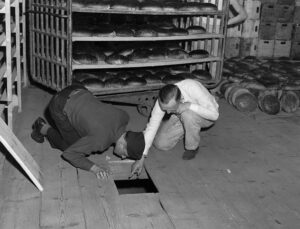 Solution…Nazi Germany’s horrific policy of deliberate and systematic genocide across German-occupied Europe. In April 1946, a member of the Nakam got a job as a baker, and he had a plan. He baked arsenic into 3,000 loaves of bread that were to be fed to the prisoners. Nearly 2,000 prisoners became ill and were thought to be seriously ill. American authorities thought that the arsenic had got onto the crust of the bread by accident, having been used as an insecticide in the wheat fields. During the investigation, United States Army investigators found enough arsenic to have killed 60,000 people and Nakam claimed they had killed several hundred victims, but declassified documents obtained by Associated Press in 2016 stated there were no casualties.
Solution…Nazi Germany’s horrific policy of deliberate and systematic genocide across German-occupied Europe. In April 1946, a member of the Nakam got a job as a baker, and he had a plan. He baked arsenic into 3,000 loaves of bread that were to be fed to the prisoners. Nearly 2,000 prisoners became ill and were thought to be seriously ill. American authorities thought that the arsenic had got onto the crust of the bread by accident, having been used as an insecticide in the wheat fields. During the investigation, United States Army investigators found enough arsenic to have killed 60,000 people and Nakam claimed they had killed several hundred victims, but declassified documents obtained by Associated Press in 2016 stated there were no casualties.
According to Harmatz’s son, his father had no regret for his attempts to kill the German prisoners. He said he was only “sorry that it didn’t work.” Harmatz wrote a book in 1998, called “From the Wings” in which he stated that the poisoning plot had the approval of Chaim Weizmann, though David Ben-Gurion and Zalman Shazar were both against the plan. An earlier attempt to poison the water in a number of German cities failed after  Kovner was arrested by British forces on a ship on which the poison had been hidden, and had been thrown overboard to prevent its capture. The group was so filled with hatred that they wanted all Germans killed, even if they had nothing to do with the Holocaust. Looking back, after much soul searching, Harmatz was thankful that the plot to poison the water supplies in German cities had failed, saying that it “would have harmed efforts to create an incipient State of Israel and would have led to charges of moral equivalence between actions of Germans and Jews. Another effort to kill Nazi war criminals on trial at Nuremberg failed when the group was unable to find any US Army guards willing to participate.”
Kovner was arrested by British forces on a ship on which the poison had been hidden, and had been thrown overboard to prevent its capture. The group was so filled with hatred that they wanted all Germans killed, even if they had nothing to do with the Holocaust. Looking back, after much soul searching, Harmatz was thankful that the plot to poison the water supplies in German cities had failed, saying that it “would have harmed efforts to create an incipient State of Israel and would have led to charges of moral equivalence between actions of Germans and Jews. Another effort to kill Nazi war criminals on trial at Nuremberg failed when the group was unable to find any US Army guards willing to participate.”
Harmatz emigrated to Israel in 1950, and worked to aid Jews resettling from countries around the world. He headed World ORT, a Jewish non-profit organization that promotes education and training in communities around the world, from 1960 to 1994. A long-time resident of Tel Aviv, Harmatz died at at his home on September 22, 2016. He was 91 years old, and was survived by two sons.
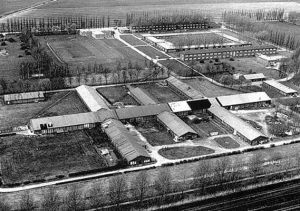 The Neuengamme concentration camp was established in December 1938, and used by the Nazis as a forced labor camp from December 13, 1938 to May 4, 1945, when it was liberated by British troops. At the time of its liberation, about half of the approximately 106,000 Jews held there over time had died. Neuengamme was located on the Elbe river, near Hamburg, Germany. One hundred inmates who were transferred from Sachsenhausen concentration camp, were forced to build the Neuengamme concentration camp. It was established around an empty brickworks in Hamburg-Neuengamme. The bricks produced there were to be used for the “Fuehrer buildings” part of the National Socialists’ redevelopment plans for the river Elbe in Hamburg.
The Neuengamme concentration camp was established in December 1938, and used by the Nazis as a forced labor camp from December 13, 1938 to May 4, 1945, when it was liberated by British troops. At the time of its liberation, about half of the approximately 106,000 Jews held there over time had died. Neuengamme was located on the Elbe river, near Hamburg, Germany. One hundred inmates who were transferred from Sachsenhausen concentration camp, were forced to build the Neuengamme concentration camp. It was established around an empty brickworks in Hamburg-Neuengamme. The bricks produced there were to be used for the “Fuehrer buildings” part of the National Socialists’ redevelopment plans for the river Elbe in Hamburg.
The prisoners worked on the construction of the camp and brickmaking. The bricks were used for regulating the flow of the Dove-Elbe river and the building of a branch canal. The prisoners were also 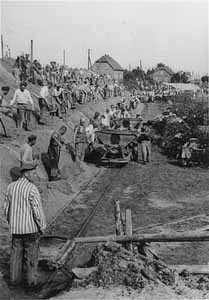 used to mine the clay used to make the bricks. That reminds me of the Jews in Egypt who were forced to build the pyramids. In 1940, the population of the camp was 2,000 prisoners, with a proportion of 80% German inmates among them. Between 1940 and 1945, more than 95,000 prisoners were incarcerated in Neuengamme. On April 10th, 1945, the number of prisoners in the camp itself was 13,500. Over the years that Neuengamme was open, it is estimated that 103,000 to 106,000 people were held there. We may never really know, because they didn’t keep clear records of all the people who went through the camps.
used to mine the clay used to make the bricks. That reminds me of the Jews in Egypt who were forced to build the pyramids. In 1940, the population of the camp was 2,000 prisoners, with a proportion of 80% German inmates among them. Between 1940 and 1945, more than 95,000 prisoners were incarcerated in Neuengamme. On April 10th, 1945, the number of prisoners in the camp itself was 13,500. Over the years that Neuengamme was open, it is estimated that 103,000 to 106,000 people were held there. We may never really know, because they didn’t keep clear records of all the people who went through the camps.
From 1942 on, the inmates were forced to work in the Nazi armament production. At first, the work was performed in the Neuengamme workshops, but soon it was decided to transfer the prisoners to the armaments factories in the surroundings areas. At the end of the war, the prisoners of Neuengamme were spread all over northern Germany. As the Allied troops advanced, hundreds of inmates were forced to dig antitank ditches. In many large north German cities, The prisoners were also require to clear rubble and removed corpses after bombing raids. There were 96 sub-camps, 20 of them for women. In early spring 1945, more than 45,000 inmates were working for the Nazi industry. A third of the women were forced to be among a part of the Nazi 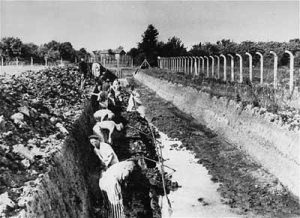 industry workforce. By this time, the internal population of Neuengamme was 13,500, which made it completely overcrowded. The estimated number of victims in Neuengamme is approximately 56,000. Thousands of inmates were hanged, shot, gassed, killed by lethal injection or transferred to the death camps Auschwitz and Majdanek. As the war neared its end, the SS decided to evacuate Neuengamme. They had hoped to avoid having them liberated…probably hoping to regroup further north. This was the start of one of the worst death marches of the war. During these death marches, approximately 10,000 inmates perished by shootings or simply starvation. Nevertheless, the Allies won this war, and then they went in and liberated the prisoners of the many death camp.
industry workforce. By this time, the internal population of Neuengamme was 13,500, which made it completely overcrowded. The estimated number of victims in Neuengamme is approximately 56,000. Thousands of inmates were hanged, shot, gassed, killed by lethal injection or transferred to the death camps Auschwitz and Majdanek. As the war neared its end, the SS decided to evacuate Neuengamme. They had hoped to avoid having them liberated…probably hoping to regroup further north. This was the start of one of the worst death marches of the war. During these death marches, approximately 10,000 inmates perished by shootings or simply starvation. Nevertheless, the Allies won this war, and then they went in and liberated the prisoners of the many death camp.
 Yesterday was National Holocaust Remembrance Day, I started thinking about all that happened to those poor victims of the Holocaust, and because yesterday was the day that the prisoners of Auschwitz were liberated, I began to contemplate what it must have been like for them as the exited that horrible camp. My guess is that their first thought was one of thankfulness that they had actually come out alive. Going into Auschwitz, I’m sure many had hopes that it would be just a camp for prisoners of war, and that they might be treated fairly, but as their friends began to disappear, never to return, I’m sure they knew to horrific truth. This was not a prisoner of war camp, is was a death camp, and the whole goal was to experiment, torture, and kill the prisoners. The people who worked there, were given authority to do as they pleased.
Yesterday was National Holocaust Remembrance Day, I started thinking about all that happened to those poor victims of the Holocaust, and because yesterday was the day that the prisoners of Auschwitz were liberated, I began to contemplate what it must have been like for them as the exited that horrible camp. My guess is that their first thought was one of thankfulness that they had actually come out alive. Going into Auschwitz, I’m sure many had hopes that it would be just a camp for prisoners of war, and that they might be treated fairly, but as their friends began to disappear, never to return, I’m sure they knew to horrific truth. This was not a prisoner of war camp, is was a death camp, and the whole goal was to experiment, torture, and kill the prisoners. The people who worked there, were given authority to do as they pleased.
As the prisoners were taken out of the camp, I’m sure there was a mixture of feelings…relief and guilt. Relief because they had lived through one of the worst atrocities in history…and guilt, because they had lived through one of the worst atrocities in history…while so many others did not. The guilt would have been horrible. Parents who made it out, while their children did not; children who made it out, while their parents did not. They were free, but homeless. They were weary, and many were sick or dying of starvation. The experiments performed on them probably left irreparable damage to their bodies and minds. I’m sure their thoughts were racing as the walked away from the worst time in their lives.
Their futures were uncertain. They didn’t know if they would be accepted in their home country, or if they 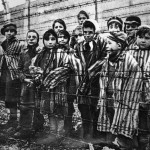 would have to immigrate to another country to find real freedom. And I’m sure that the worst thought was the possibility that it could happen again. Once something like the holocaust happened to a people, how could they possibly trust another nation again, and yet they would, because as horrible as the Holocaust was, there were many good people, and many good nations who were completely against the atrocities that happen during those years…people and nations who would never forget what happened. The Holocaust was an atrocity beyond the ability of most human beings ability to wrap their minds around, but it was something that was impossible to forget, for those who lived it. The horror they suffered would haunt them for the rest of their lives. It would be impossible to remove the nightmare they lived from their memory.
would have to immigrate to another country to find real freedom. And I’m sure that the worst thought was the possibility that it could happen again. Once something like the holocaust happened to a people, how could they possibly trust another nation again, and yet they would, because as horrible as the Holocaust was, there were many good people, and many good nations who were completely against the atrocities that happen during those years…people and nations who would never forget what happened. The Holocaust was an atrocity beyond the ability of most human beings ability to wrap their minds around, but it was something that was impossible to forget, for those who lived it. The horror they suffered would haunt them for the rest of their lives. It would be impossible to remove the nightmare they lived from their memory.
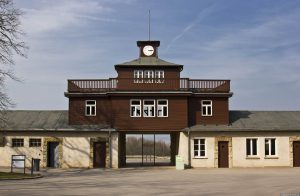 On April 11, 1945, the American Third Army liberated the Buchenwald concentration camp, near Weimar, Germany. Buchenwald was a camp that will be judged second only to Auschwitz in the horrors it imposed on its prisoners, but on this day in 1945, those horrors came to an end. The camp held thousands of prisoners, mostly slave laborers, many of whom were required to work 15 hour days. There were no gas chambers at Buchenwald, but hundreds, and sometimes thousands of prisoners, died every month from disease, malnutrition, beatings, and executions. Doctors performed medical experiments on inmates, testing the effects of viral infections and vaccines. Beginning in 1941, a number of physicians and scientists carried out a varied program of medical experimentation on prisoners at Buchenwald in special barracks in the northern part of the main camp. Medical experiments aimed at testing the efficacy of vaccines and treatments against contagious diseases such as typhus, typhoid, cholera, and diphtheria resulted in hundreds of deaths. The people these doctors were experimenting on were considered, non-human, and so their lives, or the loss thereof, were of little or no consequence to these evil doctors and scientists.
On April 11, 1945, the American Third Army liberated the Buchenwald concentration camp, near Weimar, Germany. Buchenwald was a camp that will be judged second only to Auschwitz in the horrors it imposed on its prisoners, but on this day in 1945, those horrors came to an end. The camp held thousands of prisoners, mostly slave laborers, many of whom were required to work 15 hour days. There were no gas chambers at Buchenwald, but hundreds, and sometimes thousands of prisoners, died every month from disease, malnutrition, beatings, and executions. Doctors performed medical experiments on inmates, testing the effects of viral infections and vaccines. Beginning in 1941, a number of physicians and scientists carried out a varied program of medical experimentation on prisoners at Buchenwald in special barracks in the northern part of the main camp. Medical experiments aimed at testing the efficacy of vaccines and treatments against contagious diseases such as typhus, typhoid, cholera, and diphtheria resulted in hundreds of deaths. The people these doctors were experimenting on were considered, non-human, and so their lives, or the loss thereof, were of little or no consequence to these evil doctors and scientists.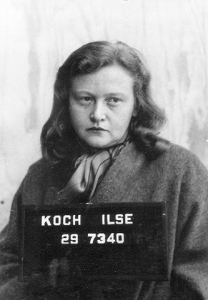
Among the camp’s most gruesome characters was Ilse Koch, wife of the camp commandant, who was infamous for her sadism. Her cruelty and heinous acts earned her the nickname, The Witch of Buchenwald. She often beat prisoners with a riding crop, and collected lampshades, book covers, and gloves made from the skin of camp victims. She was always in attendance when new prisoners were brought in. She required that they be stripped so she could examine their skin. When she found something she liked, the prisoner was killed and their skin removed for her to use. Koch was truly an evil person, and in the end, I think it all came back to haunt her, because after she was tried for a second time and given a life sentence she hanged herself at Aichach women’s prison on September 1, 1967. She was 60 years old. She was said to suffer from delusions and had become convinced that concentration camp survivors would abuse her in her cell. I think her evil ways drove her insane.
As American forces closed in on the Nazi concentration camp at Buchenwald, on April 11, 1945, Gestapo headquarters at Weimar telephoned the camp administration to announce that it was sending explosives to blow up any evidence of the camp…including its inmates. What the Gestapo did not know was that the camp administrators had already fled in fear of the Allies. A prisoner answered the phone and informed headquarters 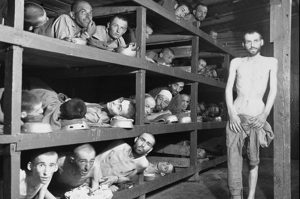 that explosives would not be needed, as the camp had already been blown up, which, of course, was not true. That act of quick thinking, saved countless lives. The sights the Allied troops saw as they entered the camps must have been sickening. People emaciated due to starvation, the smell of death everywhere, the signs of the horrific experiments that took place there. This place should never have been allowed to exist, and yet here it was. The prisoners who had managed to survive were most likely staring in stunned disbelief, not quite able to believe their eyes. Nevertheless, they had survived and they were liberated. Among those saved by the Americans was Elie Wiesel, who would go on to win the Nobel Peace Prize in 1986.
that explosives would not be needed, as the camp had already been blown up, which, of course, was not true. That act of quick thinking, saved countless lives. The sights the Allied troops saw as they entered the camps must have been sickening. People emaciated due to starvation, the smell of death everywhere, the signs of the horrific experiments that took place there. This place should never have been allowed to exist, and yet here it was. The prisoners who had managed to survive were most likely staring in stunned disbelief, not quite able to believe their eyes. Nevertheless, they had survived and they were liberated. Among those saved by the Americans was Elie Wiesel, who would go on to win the Nobel Peace Prize in 1986.
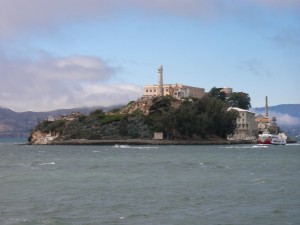 Sometimes, it has to be accepted that just maybe, something is impossible. Still, when a challenge seems impossible, there is always someone who comes along and proves that it can be done. Alcatraz island, and the prison that is located there were known to be impossible to escape from. Over the years that Alcatraz was open, there were 14 escape attempts. Myths and mysteries surrounded Alcatraz, and it’s seemingly inescapable water fortress for years. One of the many myths about Alcatraz is that it was impossible to survive a swim from the island to the mainland because of sharks. In fact, there are no “man-eating” sharks in San Francisco Bay, only small bottom-feeding sharks. The real obstacles the prisoners faced were the cold temperatures…which averaged 50 to 55 degrees Fahrenheit, the strong currents in the water, and the distance to shore, which was at least 1¼ miles. Those things combined were known to have bested most people who attempted to make it from Alcatraz to San Francisco.
Sometimes, it has to be accepted that just maybe, something is impossible. Still, when a challenge seems impossible, there is always someone who comes along and proves that it can be done. Alcatraz island, and the prison that is located there were known to be impossible to escape from. Over the years that Alcatraz was open, there were 14 escape attempts. Myths and mysteries surrounded Alcatraz, and it’s seemingly inescapable water fortress for years. One of the many myths about Alcatraz is that it was impossible to survive a swim from the island to the mainland because of sharks. In fact, there are no “man-eating” sharks in San Francisco Bay, only small bottom-feeding sharks. The real obstacles the prisoners faced were the cold temperatures…which averaged 50 to 55 degrees Fahrenheit, the strong currents in the water, and the distance to shore, which was at least 1¼ miles. Those things combined were known to have bested most people who attempted to make it from Alcatraz to San Francisco.
The prisoners tried every possible escape plan they could think of…from simply climbing over a fence to the most elaborate attempt which was made famous by the movie “Escape From Alcatraz,” when on June 11, 1962,  Frank Morris, and brothers John and Clarence Anglin cut through the walls, and made false walls to conceal their work, then placing “dummy heads” in their beds, so they would have all night to make their escape. Using raincoats turned into floatation devises, they made their escape. A cell house search turned up the drills, heads, wall segments, and other tools, while the water search found two life vests…one in the bay, the other outside the Golden Gate, oars, as well as letters and photographs belonging to the Anglins that had been carefully wrapped to be watertight. No sign of the men was found. Several weeks later a man’s body dressed in blue clothing similar to the prison uniform was found a short distance up the coast from San Francisco, but the body was too badly deteriorated to be identified. Speculation continues to this day as to whether or not the other two made it to safety.
Frank Morris, and brothers John and Clarence Anglin cut through the walls, and made false walls to conceal their work, then placing “dummy heads” in their beds, so they would have all night to make their escape. Using raincoats turned into floatation devises, they made their escape. A cell house search turned up the drills, heads, wall segments, and other tools, while the water search found two life vests…one in the bay, the other outside the Golden Gate, oars, as well as letters and photographs belonging to the Anglins that had been carefully wrapped to be watertight. No sign of the men was found. Several weeks later a man’s body dressed in blue clothing similar to the prison uniform was found a short distance up the coast from San Francisco, but the body was too badly deteriorated to be identified. Speculation continues to this day as to whether or not the other two made it to safety.
The official statement says they drown, and while it is likely that they did, it has been proven that it was indeed possible to swim from Alcatraz to San Francisco. Prior to the Federal institution opening in 1934, a teenage girl swam to the island to prove it was possible. Fitness guru Jack LaLanne swam to the island pulling a rowboat,  and several years ago two 10 year old children also made the swim. The official stand on that is that if a “person is well trained and conditioned, it is possible to survive the cold waters and fast currents. However, for prisoners, who had no control over their diet, no weightlifting or physical training (other than situps and pushups), and no knowledge of high and low tides, the odds for success were slim.” As to the escape attempts in which no body was ever found, we will never really know if they somehow managed to beat the odds and went on to live a quiet life under an assumed name or if they were swept away to be basically buried at sea. Either way, it is a very interesting subject to speculate on. I personally think that at least one of the three men made it.
and several years ago two 10 year old children also made the swim. The official stand on that is that if a “person is well trained and conditioned, it is possible to survive the cold waters and fast currents. However, for prisoners, who had no control over their diet, no weightlifting or physical training (other than situps and pushups), and no knowledge of high and low tides, the odds for success were slim.” As to the escape attempts in which no body was ever found, we will never really know if they somehow managed to beat the odds and went on to live a quiet life under an assumed name or if they were swept away to be basically buried at sea. Either way, it is a very interesting subject to speculate on. I personally think that at least one of the three men made it.

